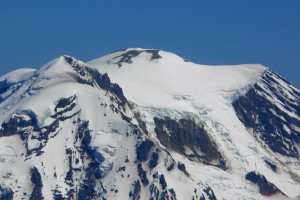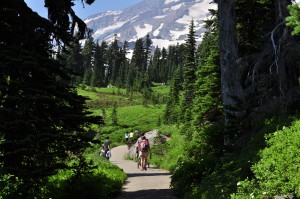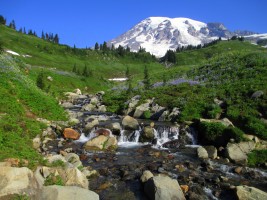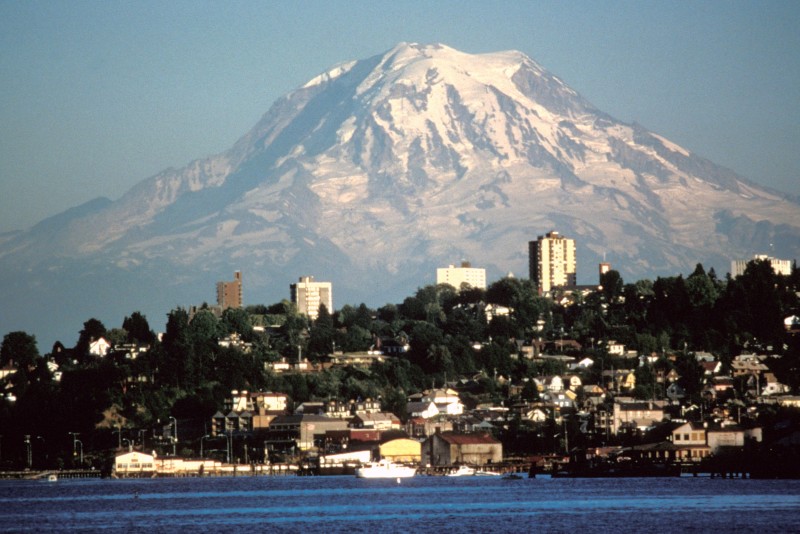Mount Rainier (originally named Tahoma) is a big presence in our city, so we decided to frame our overview here in terms of mountain locations, starting from the summit, down the trails, to the meadows, and finally, to Tacoma!
 Macro view: From the summit
Macro view: From the summit
If this is the first time you’re submitting a proposal for a conference, you’re probably wondering what exactly is expected of you. As with any genre of writing, the most important thing about a conference proposal is having something you want to say. If you’re still thinking about what you would like to present, consider the theme of the conference, “It’s for Everyone: The Inclusive Writing Center,” and look again at the call for proposals. Though it’s not necessary for every presentation to relate to the conference theme, that theme will be a coherent thread through the conference.
Meso view: From the trails
 One of the most important things to consider when writing a conference proposal is what contribution you’re making to writing center scholarship.
One of the most important things to consider when writing a conference proposal is what contribution you’re making to writing center scholarship.
The goal is to move the discussion forward, and you should always include an explanation of why your paper is an important scholarly contribution. As you’re refining your proposal idea, do some reading to find out what has been established already in your topic of interest and where you might find gaps in the scholarship. Good places to look for writing center scholarship are
- The Dangling Modifier: An International Newsletter By and For Peer Tutors in Writing and Produced in Association with the NCPTW
- Praxis: A Writing Center Journal
- WLN: A Journal of Writing Center Scholarship
- Writing Center Journal
As with most things, though, it can also be helpful to look beyond the directly relevant scholarship, in order to offer new perspectives. You may find that things you are reading in your courses outside the writing center resonate with what you’re seeing (and not seeing) in your peer tutoring. Those moments of connection can be valuable places to start thinking.
Micro view: From the meadows
 The proposal for NCPTW consists of two main elements: the proposal proper, which is a brief (500 word maximum) summary of what your presentation, workshop, or panel will be about; and an abstract, which is an even briefer (75 word maximum) description intended for the conference program.
The proposal for NCPTW consists of two main elements: the proposal proper, which is a brief (500 word maximum) summary of what your presentation, workshop, or panel will be about; and an abstract, which is an even briefer (75 word maximum) description intended for the conference program.
Both of those pieces should give readers a good sense of what question your presentation will address, how you’re going about addressing it, and what claim(s) you’re making. Because you are proposing something that you may not have researched yet (let alone written), it is very likely that the longest part of your proposal will be the part describing the problem or question you’re addressing, and the shortest part will be about the claims you’re making. That’s okay! Even after you’ve written your paper, you may find that you still have more questions than answers. That, too, is okay, as long as you’re asking questions from a different angle or are asking questions that build on what other people have already said.
You will likely recycle some text from your proposal in your abstract, and that’s fine. Keep in mind, though, the slightly different purposes for the proposal and the abstract.
- The proposal demonstrates that you’re engaging in a substantive way with questions of shared interest with other NCPTW conference-goers—AND that you have a good idea of how you will offer something new. If you're proposing an individual paper and need to be placed on a panel, the proposal's description of your questions and methods is also helpful to conference planners in joining you with other presenters whose work intersects well with yours.
- The abstract is somewhat less about demonstrating that you have a sense of the field and a plan for engaging it; it is more about attracting attendees to the conference and about boiling down the most essential elements of your proposal. And, of course, you will want to have a catchy, informative title that will convey your ideas in even briefer format than your proposal or abstract.
As with any application process, conference proposals involve relatively few words, but each of those words counts. We look forward to reading your proposals! Hope to see you in Tacoma in November!
